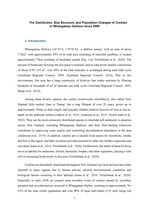· Adkins, S. C., Marsden, I. D., & Pirker, J. G. (2014). Variation in Population Structure
· and Density ofAustrovenus stutchburyi(Veneridae) from Canterbury, New Zealand. Journal of Shellfish Research, 33(2), 343–354. https://doi.org/10.2983/035.033.0204
· Altieri, A. H., & Gedan, K. B. (2014). Climate change and dead zones. Global Change Biology, 21(4), 1395–1406. https://doi.org/10.1111/gcb.12754
· Anderson, T., Barrett, H., & Morrisey, D. (2019). Effects of sediment deposition on the New Zealand cockle, Austrovenus stutchburyi. New Zealand Journal of Marine and Freshwater Research, 53(3), 363–376. https://doi.org/10.1080/00288330.2019.1580751
· Auckland Regional Council. (2009). Whangateau Catchment and Harbour Study Review of Environmental and Socio- economic Information. https://docs.niwa.co.nz/library/public/9781877528101.pdf
· Auckland Regional Council. (2010). Ecological communities and habitats of Whangateau Harbour 2009. https://knowledgeauckland.org.nz/media/1790/tr2010-057-whangateauecological-monitoring.pdf
· Burge, C. A., Closek, C. J., Friedman, C. S., Groner, M. L., Jenkins, C. M., ShoreMaggio, A., & Welsh, J. E. (2016). The Use of Filter-feeders to Manage Disease in a Changing World. Integrative and Comparative Biology, 56(4), 573–587. https://doi.org/10.1093/icb/icw048
· Fenberg, P. B., & Roy, K. (2008). Ecological and evolutionary consequences of sizeselective harvesting: how much do we know? Molecular Ecology, 17(1), 209–220. https://doi.org/10.1111/j.1365-294x.2007.03522.x
· Fisheries New Zealand. (2021). COCKLES (COC) – May Plenary Report 2021
· Volume 1. https://fs.fish.govt.nz/Doc/25028/14%20COCintro%202021.pdf.ashx
· Fisheries. Whangateau Harbour Cockle and Pipi Harvest Closure. Notice 2010. Notice No. F515. (N. Z.). https://gazette.govt.nz/notice/id/2010-go1449 Fisheries. Whangateau Harbour Cockle and Pipi Harvest Closure. Notice 2013.
· Notice No. MPI 130. (N. Z.). https://gazette.govt.nz/notice/id/2013-go985
· Fisheries. Whangateau Harbour Cockle and Pipi Harvest Closure. Notice 2015.
· Notice No. MPI 567. (N.Z.). https://gazette.govt.nz/notice/id/2015-go7264
· Jones, H. F. E., Pilditch, C. A., Hamilton, D. P., & Bryan, K. R. (2016). Impacts of abivalve mass mortality event on an estuarine food web and bivalve grazing pressure. New Zealand Journal of Marine and Freshwater Research, 51(3), 370–392. https://doi.org/10.1080/00288330.2016.1245200
· Lundquist, C. J., Pilditch, C. A., & Cummings, V. J. (2004). Behaviour controls postsettlement dispersal by the juvenile bivalves Austrovenus stutchburyi and Macomona liliana. Journal of Experimental Marine Biology and Ecology, 306(1), 51–74. https://doi.org/10.1016/j.jembe.2003.12.020
· Marsden, I. D., & Adkins, S. C. (2009). Current status of cockle bed restoration in New Zealand. Aquaculture International, 18(1), 83–97.
· https://doi.org/10.1007/s10499-009-9270-6 Marsden, I. D., & Bressington, M. J. (2009). Effects of macroalgal mats and hypoxia on burrowing depth of the New Zealand cockle (Austrovenus stutchburyi). Estuarine, Coastal and Shelf Science, 81(3), 438–444. https://doi.org/10.1016/j.ecss.2008.11.022
· Ministry for Primary Industries. (2015). Proposed closures to the recreational harvesting of cockle and pipi at Ngunguru and Whangateau. https://www.mpi.govt.nz/dmsdocument/10070/direct
· Mouritsen, K. N., & Poulin, R. (2003). The mud flat anemone-cockle association:
· mutualism in the intertidal zone? Oecologia, 135(1), 131–137. https://doi.org/10.1007/s00442-003-1183-x
· Richardson, C. A., Crisp, D. J., & Runham, N. W. (1980). Factors Influencing Shell Growth in Cerastoderma edule. Proceedings of the Royal Society of London.
· Series B, Biological Sciences, 210(1181), 513–531. https://www.jstor.org/stable/35392?seq=1
· Tricklebank, K. A., Grace, R. V., & Pilditch, C. A. (2020). Decadal population dynamics of an intertidal bivalve (Austrovenus stutchburyi) bed: pre- and posta mass mortality event. New Zealand Journal of Marine and Freshwater Research, 55(2), 1–23. https://doi.org/10.1080/00288330.2020.1772323
· Wei, Z., Xin, L., Zhang, W., Bai, C., Wang, C., & Li, C. (2019). Isolation and characterization of Vibrio harveyi as a major pathogen associated with mass mortalities of ark clam, Scapharca broughtonii, in summer. Aquaculture, 511, 734248–734248. https://doi.org/10.1016/j.aquaculture.2019.734248
· Zwarts, L., & Wanink, J. (1989). Siphon size and burying depth in deposit- and
· suspension-feeding benthic bivalves. Marine Biology, 100(2), 227–240. https://doi.org/10.1007/bf00391963

